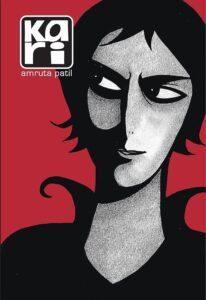
Kari by Amruta Patil is considered the first lesbian graphic novel in India. The book opens with a double suicide pact, which turns out to be unsuccessful, and the narrator falls into a sewer. The story takes place in the big metropolitan city of Mumbai, which is referred to as the "smog city" in the book. There are various panels in the book which depict the myriad smells of the smog city and the acrid fumes which colour the surroundings dark and bleak. It's an unflinching and raw portrayal of living in overcrowded and polluted metropolitan cities as a young queer person attempting to navigate it. The narrator uncovers discreet paths and routes whilst walking through the city, leading to surprising connections with new people, but at the same time, she loses these paths and never finds them again. It highlights the transience and the enigmatic corners of this ever-changing city where people navigate it in their own personal ways to make it livable.
Kari, the protagonist, lives with two other roommates who always have their boyfriends around. Even though she lives in a big city, she finds it difficult, almost impossible, to discover queer spaces within the heteronormative framework. She is constantly bothered by her roommates, who want to turn her more "girly," and she presents as a threat to the norm by dressing and presenting in a masculine fashion. Even her co-worker hits on her, though he is aware of her identity as a lesbian. The illustrations in the book mirror Kari's grim and isolated reality.
Her ex-lover, Ruth, is constantly evoked through Kari's memories. Ruth, or the symbolic figure of Ruth, is what holds the narrative together and forms the central core around which Kari's musings and longings are weaved and continue to shape her identity in the present. She refers to Ruth as the one holding her heart in her palms like a blue thing-a marble, bauble or an egg. She sees Ruth as this enigmatic princess, a bullet in her stomach and a wound that she nurses every month. She immortalises as well as mystifies Ruth in her recollections, and we don't get to know Ruth as a person even when the book ends. However, her loneliness and perpetual desolation are evident throughout the book, and it becomes apparent that it is symptomatic of city life in a particularly interesting scene where nobody pays attention or even looks at a battered woman on an overcrowded bus, underscoring how people are distant from each other, unable to communicate.
The writing style is sensuous and vivid, flowing clearly unlike the city depicted in the book. It also highlights how genuine bonds and communities are formed even under unlivable conditions. Kari forms a heartwarming bond with Angel who is a dying cancer patient who is bald because of her sickness. Kari describes her friend fondly throughout the book, revealing their shared tender memories together and their admiration towards each other. Kari finds Angel's no-nonsense and blunt attitude refreshing, and Angel takes the role of her mentor and a close friend until she passes away.
Additionally, Angel refers to Kari as a "boatman" which has profound connotations in the context of the book. It is linked to the symbol of the sewer in the book, which imbibes the city's waste and is about to explode. Kari, as a boatman, wants to unclog the bursting sewers of the city, providing relief to the veins of the city. The symbol of Boatman could also refer to her position in a unique liminal space within the orthodox Indian society, where she draws the inspiration for the shaping of her identity from queer icons aboard. She represents the all too familiar and relatable experiences of queer Indians in urban settings who have to appropriate, modify and reshape queer icons aboard to navigate the harsh realities of their everyday cultural spaces that are inherently heteronormative. Finding almost no precedents or role models to look up to in our own cultural settings and having no language to articulate our identities, we make do with whatever representations we can get our hands on and become Boatmen, traversing and giving rise to a hotchpotch of mixed multicultural spaces.
However, things are changing rapidly as we speak, and it is books like these that document and provide a genealogy of queer Indians, marking our place in history and culture and reclaiming spaces denied to us for too long.
